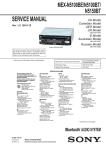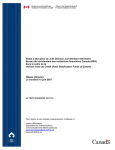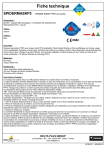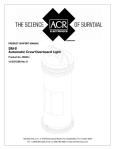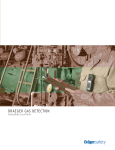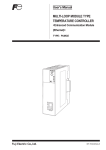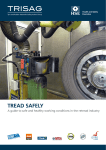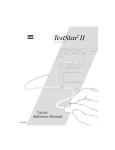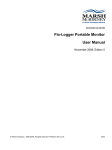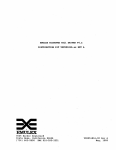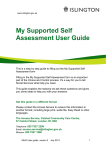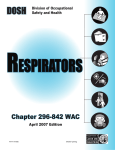Download BSIF RPE Fit Test Accreditation Scheme `Fit2Fit`– Syllabus January
Transcript
BSIF RPE Fit Test Accreditation Scheme ‘Fit2Fit’– Syllabus January 2015 Subject / Content Depth required to be assessed as Competent Section1. Knowledge of RPE Sets out the minimum knowledge requirements in respect of respiratory protective equipment. [Mandatory] A general understanding of RPE use in the workplace Demonstrates a general 1.1 understanding of HSG 534th General Edition knowledge Demonstrates in depth knowledge and understanding of HSG53 paragraphs 36-39, 25-32 and 33 35. Demonstrates an understanding of the terms ‘adequate’ and ‘suitable’ in relation to RPE Understanding of selection and fit testing. Demonstrates in depth knowledge and understanding of HSG 53 paragraphs 45 & 47-48 and The nature of potential hazards which RPE can protect against information in Table 1. Implementing RPE use in the workplace The need for training in the use of RPE Demonstrates in depth knowledge and understanding of HSG 53 paragraphs 76-8, 84-86 and 90 97. NB. The ability to select suitable and adequate RPE is not required during the assessment however the candidate should have the ability to Identify where the selection of RPE is obviously incorrect. Page 1 of 18 BSIF RPE Fit Test Accreditation Scheme ‘Fit2Fit’– Syllabus January 2015 1.2 Protection factors Understanding of Protection factors and fit factors: Fit factor Assigned PF Nominal PF 1.3 Types and classes Knowledge of the range of RPE available Filters Negative pressure filtering respirators Power assisted filtering respirators Powered filtering respirators Air-fed devices Fresh Air Hose Self Contained Breathing Apparatus Demonstrates an understanding and the correct application of the term fit factor and of the various protection factors defined in EN529 para 3.2, 3.6, 3.11, & HSE282/28 para 33 Demonstrates in depth knowledge and understanding of HSG 53 paragraphs 11-18, & EN529 Section 4. General understanding of all generic RPE types: Filtering devices Breathing apparatus Recognises and can identify different models and classes of RPE. Demonstrates a general knowledge of the range of RPE, their function, capabilities and limitations as included in HSG53 pages 28 -42 NB. This does not have to be manufacturer specific although an awareness of different manufacturers’ models would be desirable. Page 2 of 18 BSIF RPE Fit Test Accreditation Scheme ‘Fit2Fit’– Syllabus January 2015 1.4 Assembly, Inspection, maintenance prior to fit testing 1.5 Donning prior to fit testing Understanding of the purpose of, and demonstrates a practical ability in: Assembly of facepiece Examination of facepiece Exhalation valve Filter (differentiate between that used for the fit test and that used in use) Faceseal Head harness Knows and can demonstrate how to assemble and check the condition of the facepiece prior to fit testing Knowledge of COSHH Reg. 8(1) and para 168(c) Knowledge of manufacturers’ instructions Understands: The nature and significance of wearer related factors The importance of following the manufacturer’s instructions Demonstrates in depth knowledge and understanding of HSG 53 paragraph ‘wearer related factors’ pages 18-20 and information in Table 3and in HSE 282/28 para 98. Knowledge of COSHH Reg. 8(1) and para 168(c) Generic rules for donning Understanding of the purpose of and demonstrates a practical ability in: Fit checking Visual inspection of fit Demonstrates the ability to give instruction on correct donning including fit-checking Demonstrates the ability to recognise a poor fit and give appropriate corrective advice Page 3 of 18 BSIF RPE Fit Test Accreditation Scheme ‘Fit2Fit’– Syllabus January 2015 Section 2. The Role of Fit Testing Sets out the minimum knowledge and understanding requirements in respect of the need for fit-testing of respiratory protective equipment. [Mandatory] Understands the role of RPE Fit Testing, plus: Demonstrates in depth knowledge 2.1 and understanding of the role of Required Legal Where to find relevant regulations e.g. COSHH, CAR etc. RPE fit testing and where this fits Knowledge and The need for training in the application of fit testing into the legal framework Understanding HSE282/28 parts 1 & 2. Also: HSG 53 para 84-86 COSHH Reg. 7 relating fit testing (158-162) CAR Reg. 11 relating to fit testing (301-309) 2.2 Purpose of fit testing Understands the purpose of fit testing and when it is required Understanding of the term tight-fitting and the applicable types of facepiece When fit testing should be carried out When it doesn’t need to be carried out When fit testing should be repeated Demonstrates understanding of the purpose of fit testing, which type of RPE requires it & when fit testing is inappropriate. When you should not carry out fit testing When the requirements on the wearer are not fulfilled When you believe that the device is inadequate for the workplace conditions. Page 4 of 18 BSIF RPE Fit Test Accreditation Scheme ‘Fit2Fit’– Syllabus January 2015 Section 3. Principles of Fit Testing Sets out the minimum knowledge and understanding requirements in respect of the principles involved in carrying out effective respiratory protective equipment fit testing. [Mandatory] Demonstrates knowledge of how 3.1 Qualitative bitrex, saccharin, isoamyl acetate- (wearer must be sensitive) each of the fit test methods Fit test methods Quantitative Portacount, (sufficient ambient particle count, wearer generated included in 282/28 works and particles) their limitations of use Quantitative test chamber (need facilities and expensive equipment) Quantitative CNP (high demands on wearer holding breath etc.) Aware of problems and takes Types of facepiece which may be tested with each method and why appropriate actions Type of filter which needs to be used and why Problems which may be encountered Fit test exercises Understands the purpose of the 3.2 exercises. Fit test exercises Their purpose Provide suitable instructions What they are and how they should be carried out including time Employs the exercises Precautions What you should do if the wearer is unable to carry out some of the exercises. Understands actions if wearer is unable to carry out exercises Understands the important factors 3.3 Understanding of what the test involves to be considered before Information for Smoking performing a fit test. and requirements Eating and drinking Considers relevant H&S of the wearer Facial hair Wear other head worn PPE or medical corrective devices which will be Understands the role and required when working responsibility of the employee in relation to fit testing HSE 282/28 Para 98 Understands the role and 3.4 Adequately communicated information and requirements to the wearer Requirements of Arrange for suitable spectacle frames to be available if spectacles are required responsibility of the employer in relation to fit testing employer for working whilst wearing a full facemask Suitable room if the test is to take place on the employers premises Declaration that the wearer is medically fit to carry out the fit test (preferably in writing from the employer) Page 5 of 18 BSIF RPE Fit Test Accreditation Scheme ‘Fit2Fit’– Syllabus January 2015 3.5 Examination of facepieces for adequate condition for fit testing 3.6 Record keeping Facepiece body clean and undamaged including faceseal Visor clean and undamaged Head harness adjustable and undamaged Valves present and in good condition. Knowledge of how to assemble and to check the condition of the facepiece prior to fit testing Wearer details Facepiece details Results Service provider details Equipment details Knows what details to record Take suitable care with data 3.7 Preparing the wearer Explain purpose of a fit test and how this test works What will be required of the wearer, e.g. breathe through mouth for QLFT, exercises, indicate when can taste/smell the test agent Check wearer requirements re facial hair, smoking, eating etc Wearer dons facepiece correctly following manufacturer’s instructions Wearer correctly carries out fit check Visual inspection of fit Wearer tries out treadmill, step, bike (knows how to operate device) Means of communicating with wearer confirmed Understands the role and responsibility of the employee in relation to fit testing Takes due care H&S Explains the purpose of the fit test Explains what is required from the wearer Knows when to refuse to conduct a fit test Page 6 of 18 BSIF RPE Fit Test Accreditation Scheme ‘Fit2Fit’– Syllabus January 2015 3.8 Post test requirements 3.9 Diagnosing failures Cleaning & disinfection of facepiece and fit testing equipment Removal of probes Putting the RPE back into service De-brief wearer on fit test findings Visual examination of the face fit Corrective actions before re-testing Fit test equipment diagnostic checks Visual examination of the facepiece (3.5) Understands the importance of cleaning & disinfection Takes suitable step to ensure correct functioning of the fit test equipment Knows how to remove probes and put the RPE back into service. Knowledge of possible problems that may cause an unsuccessful fit test. Understands what actions to take following an unsuccessful fit test. Demonstrates the practical ability to investigate the possible causes of an unsuccessful fit test and takes appropriate actions Understands the implications of an unsuccessful fit test. HSE282/28 paras100 –10 and, 117. Fit test equipment manufacturer’s instructions. Page 7 of 18 BSIF RPE Fit Test Accreditation Scheme ‘Fit2Fit’– Syllabus January 2015 3.10 Interpretation of results Understands the pass/fail criteria applicable to the type of RPE tested the factors that lead to uncertainties in the fit test results how to correctly recognise and interpret fit test results where the result is borderline or could have been affected by a factor other than fit. Demonstrates knowledge of the idiosyncrasies of the fit testing equipment being used and the potential factors that may give false results, potential reasons for failures, characteristics of generic masks types and inherent design issues of the RPE and fit test method that would have adverse effects on the fit test result HSE282/28 para 24. Section 4. Fit Test Methods Presented as a series of optional elements, this section sets out the specific knowledge and understanding requirements necessary to carry out each method of fit-test and for each type of respiratory protective equipment. [Compliance with one or more of the optional elements is mandatory] Method 1. Qualitative fit testing using a taste responsive method An understanding of: Demonstrates what equipment is 4.1.1 required and the standards that Knowledge of Principles of the taste test. are relevant to the equipment equipment When it is appropriate to use this method. Demonstrates knowledge of report required format defined in HSE 282/28 para 84. 4.1.2 Environmental requirements An understanding of: Need for a well ventilated room. Ref. Manufacturer’s Instructions & HSE 282/28Para 53 Demonstrates an understanding of what environmental requirements are necessary for QLFT Page 8 of 18 BSIF RPE Fit Test Accreditation Scheme ‘Fit2Fit’– Syllabus January 2015 4.1.3 How to prepare the equipment 4.1.4 Sensitivity test 4.1.5 Fit test Preparing the hood Filling the nebulisers, checking correct functioning Checking the facepiece and user instructions Conduct sensitivity test: Brief wearer. Conduct test. Record result. Conduct fit test: Brief wearers on the conduct, safety and test procedure: Observe donning of respirator and fit check Ensure palette is clear of residual taste from the sensitivity test Maintain control of the wearer during the test Ensure the appropriate concentration of test agent is maintained throughout the test Observe the wearer and function of equipment throughout test Record results. Clean equipment. Demonstrates knowledge of how to prepare the fit test equipment and check that it is working correctly prior to the test as defined in manufacturers’ instructions and HSE 282/28 para 51 Demonstrates knowledge of conducting sensitivity test as defined in manufacturers’ instructions. Takes appropriate step and actions in appropriate sequence. Demonstrates in depth understanding of manufacturers’ instructions. Demonstrates knowledge of exercises defined in HSE 282/28 para 81. Demonstrates understanding of the meaning of the results and ability to explain the consequences of the result. Page 9 of 18 BSIF RPE Fit Test Accreditation Scheme ‘Fit2Fit’– Syllabus January 2015 4.1.6 Troubleshooting An understanding of: The options available following a negative response to the sensitivity test When a re-test is appropriate Examination of the facepiece What to communicate to wearer and employer Diagnose and rectify problems with the fit of the facepiece Diagnose and rectify problems with the fit test equipment Demonstrates knowledge of troubleshooting following manufacturers’ instructions and general knowledge of test method. An understanding of: Demonstrates knowledge of the circumstances which may What to consider if the wearer completes the test without tasting the test influence the result of the test solution What to consider if the wearer indicates that they taste the test solution What to consider if the wearer indicates that they think they may have tasted the test solution Method 2. Quantitative fit testing using a Particle Counting Device (TSI Portacount Respirator Fit Tester) An understanding of: Demonstrates an understanding of 4.2.1 how the Portacount works and its Knowledge of the How the Portacount functions and how it can be used to assess the fit of tight role in fit testing Ref: TSI Portacount fitting RPE. Portacount Operation and Service The modes of operation. Manual. Safe use of the Portacount Ref: www.tsi.com 4.1.7 Interpretation of results Understands the safety risks and how to control them when using or maintaining the Portacount Ref: TSI Portacount Operation and Service Manual Ref: www.tsi.com Page 10 of 18 BSIF RPE Fit Test Accreditation Scheme ‘Fit2Fit’– Syllabus January 2015 4.2.2 Set-up the Portacount ready for use. An understanding of: The environment required for Portacount Quantitative fit testing. How to assemble hardware ready to perform daily checks. Demonstrates a good understand of the considerations when selecting a suitable location. Configure the software and perform the following tasks: Demonstrates awareness of minimum ambient particle concentration. Select/create a user database Populate people database. Populate the respirator database. Select applicable protocol database. An understanding of daily checks: Their purpose and how to perform them. The causes of failure. Demonstrates practical skill in setting–up the Portacount / computer and using the software Ref: Portacount Operation and Service Manual. Ref: www.tsi.com Demonstrates use of the daily check software. Understanding of what it does, and remedial action which may be necessary. Ref: Portacount Operation and Service Manual. Ref: software user manual. Ref: www.tsi.com Page 11 of 18 BSIF RPE Fit Test Accreditation Scheme ‘Fit2Fit’– Syllabus January 2015 4.2.3 Prepare a RPD for fit testing using an adaptor Use an adaptor kit to prepare a RPD for fit test: Use adaptor kit with inlet valve access. Use adaptor kit with outlet valve access. Use suitable filter’s for fit testing Correctly position the sample tube termination 4.2.4 Conduct a fit test Perform a quantitative fit test using the Portacount on an individual wearing an RPD. Brief wearer on the conduct, safety and test procedure Observe donning of respirator and conduct pre- use fit check Maintain control of the wearer during the test Observe the wearer and function of equipment throughout test Record results Clean equipment Procedures if fit test fails: Investigate reason for fit test failure Fit Test Equipment Wearer 4.2.5 Post fit test requirements Close down the Portacount and pack away. Demonstrates practical skill in preparing RPD for fit testing. Ref as per manufacturers’ adaptor kit user instructions. Portacount Operation and Service Manual. Ref: www.tsi.com HSE 282/28 paras 55,56,57 &58 Demonstrates in depth understanding of and practical skill in how to perform a fit test. Demonstrating consideration for the safety of the wearer Portacount Operation and Service Manual. Ref: software user manual Ref: www.tsi.com Ref: Portacount Operation and Service Manual. Ref: software user manual. RPD manufacturer user guide. Ref: www.tsi.com Demonstrates an understanding and practical skill in how to close down the Portacount. Ref: Portacount Operation and Service Manual. Ref: www.tsi.com Page 12 of 18 BSIF RPE Fit Test Accreditation Scheme ‘Fit2Fit’– Syllabus January 2015 4.2.6 Portacount maintenance 4.2.7 Troubleshooting 4.2.8 Interpretation of results Perform user maintenance task on the Portacount as required Requirements for calibration An understanding of: When a re-test is appropriate. Examination of the facepiece. What to communicate to wearer and employer. Diagnose and rectify problems with the fit of the facepiece Diagnose and rectify problems with the fit test equipment Suspiciously high fit factors Demonstrates an understanding of what user maintenance is required and the knowledge and practical skills required for carrying these out. Ref: Portacount Operation and Service Manual. Ref: www.tsi.com Demonstrates knowledge of troubleshooting following manufacturers’ instructions and general knowledge of test method. Interpretation of results o Border line pass o Wearer generated particles o Out of trend pass fit factors Page 13 of 18 BSIF RPE Fit Test Accreditation Scheme ‘Fit2Fit’– Syllabus January 2015 Method 3. Quantitative fit testing using a Particle Counting Device (TSI Portacount Plus Respirator Fit Tester) and N95 Companion or TSI Portacount Pro+ 8038 with in - built N95 Technology Portacount Pro+; Demonstrates capability to use built in N95 facility. Demonstrate knowledge and the 4.3.1 skills required to set-up Set-up and ready Portacount Plus 8020 with N 95 companion; Demonstrates how to connect the N95 Companion to the Portacount Plus 8020and set up software ready for fit testing equipment for fit testing filtering for use disposable FFP/ half mask: facepieces. Knows how to set-up and operate the particle generator 8026. 4.3.2 Conduct a fit test Perform a quantitative fit test using the N95 and Portacount on an individual wearing an RPD. Prepare RPD for fit testing (4.2.4) Brief wearer on the conduct, safety and test procedure Observe donning of respirator and fit check Maintain control of the wearer during the test Observe the wearer and function of equipment throughout test Record results Clean equipment Ref: Portacount Operation and Service Manual. Ref: N95 Companion Operation and Service Manual. Ref: Model 8026 Particle Generator Operation and Service Manual. Ref: www.tsi.com Demonstrate individual ability to perform a fit test. Ref: Portacount Operation and Service Manual. Ref software user manual. Ref: Model 8026 Particle Generator Operation and Service Manual. Ref: N95 Companion Operation and Service Manual. Ref: www.tsii.com Procedures if fit test fails: Investigate reason for fit test failure Fit Test Equipment Wearer. Page 14 of 18 BSIF RPE Fit Test Accreditation Scheme ‘Fit2Fit’– Syllabus January 2015 4.3.3 Closedown hardware components and pack away. 4.3.4 Perform maintenance task on the Particle generator model 8026 4.3.5 Perform maintenance task for the N95 companion Closedown Portacount. As above Selection of particle generator model 8026 user maintenance task. Prepare maintenance task for student: 4.3.6 Troubleshooting An understanding of: When a re-test is appropriate. Examination of the facepiece. What to communicate to wearer and employer. Diagnose and rectify problems with the fit of the facepiece Diagnose and rectify problems with the fit test equipment Suspiciously High Fit Factors 4.3.7 Interpretation of results Selection of N95 companion user maintenance task Requirements for maintenance Ref: Model 8026 Particle Generator Operation and Service Manual. Ref: www.TSI.com Prepare maintenance task for student. Ref: N95 Companion Operation and Service Manual. Ref: www.TSI.com Demonstrates knowledge of troubleshooting following manufacturers’ instructions and general knowledge of test method. Interpretation of results o Border line pass o Wearer generated particles o Out of trend pass fit factors Page 15 of 18 BSIF RPE Fit Test Accreditation Scheme ‘Fit2Fit’– Syllabus January 2015 Method 4. Controlled negative pressure (CNP) An understanding of: 4.4.1 Knowledge of How the CNP functions and how it is used to measure the face fit with a tightControlled fitting facepiece. Negative Pressure Modes of operation. Device The potential safety hazards (Fit Tester 3000) 4.4.2 CNP within calibration Equipment Means of recording the instrument measurements e.g. computer and software required Suitable fit test adapter for CNP method and type of mask being fit tested 4.4.3 Test equipment preparation Set-up the CNP ready for use. An understanding of: How to assemble the hardware Measuring instrument checks (calibration etc) ensure they are saved on the system and a print out is saved to the records file. Setting the appropriate negative test pressure Setting up the appropriate test exercises and sample times Checking the facepiece and user instructions Using the correct pass/fail criteria Configure the software and perform the following task: 4.4.4 Prepare a RPD for fit testing using an adaptor Select/create a user database Populate the people database. Populate the respirator database Select the applicable protocol from the database. Use a suitable adaptor to prepare the RPD for fit test Ref: OHD operation and service manual. Demonstrates knowledge of what equipment is required Demonstrates knowledge of how to prepare the fit test equipment and the practical skills in setting up the equipment and database for recording the test Ref: OHD user operating manual Demonstrates use of the CNP instrument checks. Understanding of what it does, and remedial action which may be necessary Demonstrates practical skill in preparing RPD for fit testing. Page 16 of 18 BSIF RPE Fit Test Accreditation Scheme ‘Fit2Fit’– Syllabus January 2015 4.4.5 Conduct a fit test Perform a quantitative fit test using the FitTester 3000 on an individual wearing a tight-fitting face mask. Brief wearers on the conduct and safety and the test content Maintain control of the wearer during the test. (Note: For this method it is more essential that there is good communication between the wearer and the fit tester) Monitor the wearer and function of equipment throughout the test to ensure correct application and breath holding during the test Ensure that the start of the fit factor measurements, following each fit test exercise, and the point at which the wearer holds their breath are correctly synchronized. Manage the fit test data Demonstrates in depth understanding of and the practical skills in how to perform a fit test. Demonstrates in depth knowledge of the requirements on the wearer during the fit test. Demonstrates consideration for the safety of the wearer. Procedures if the fit test fails Investigate reason for the fit test failure 4.4.6 Post fit test Close down the equipment and store for safe transit 4.4.7 CNP user maintenance 4.4.8 Troubleshooting Perform user maintenance task on the FitTester 3000 as required Requirements for calibration An understanding of: When a re-test is appropriate Examination of the facepiece What to communicate to wearer and employer Diagnose and rectify problems with the fit test equipment Demonstrate an understanding and practical skill in closing down the equipment Ref:OHD user operating manual Part number 9508-0344 revision A Demonstrates knowledge of troubleshooting following manufacturers’ instructions and general knowledge Ref: OHD user operating manual HSE282/28 paras 74 - 79 Page 17 of 18 BSIF RPE Fit Test Accreditation Scheme ‘Fit2Fit’– Syllabus January 2015 4.4.9 Interpretation of results Interpretation of results Border line pass “Re-test advised” message Out of trend pass fit factors The effect of excessive negative test pressures The effect of a short fit test time Demonstrates knowledge of the circumstances which may influence the result of the tests. Demonstrates knowledge of the suitable corrective actions Ref: OHD user operating manual HSE282/28 paras 74 - 79 Method 5. Test chamber (BSEN136/BSEN140/BSEN149) 4.5.1 Applicable quality and competence standards: UKAS/ISO 17025 accreditation ISO 9001 certification Page 18 of 18


















